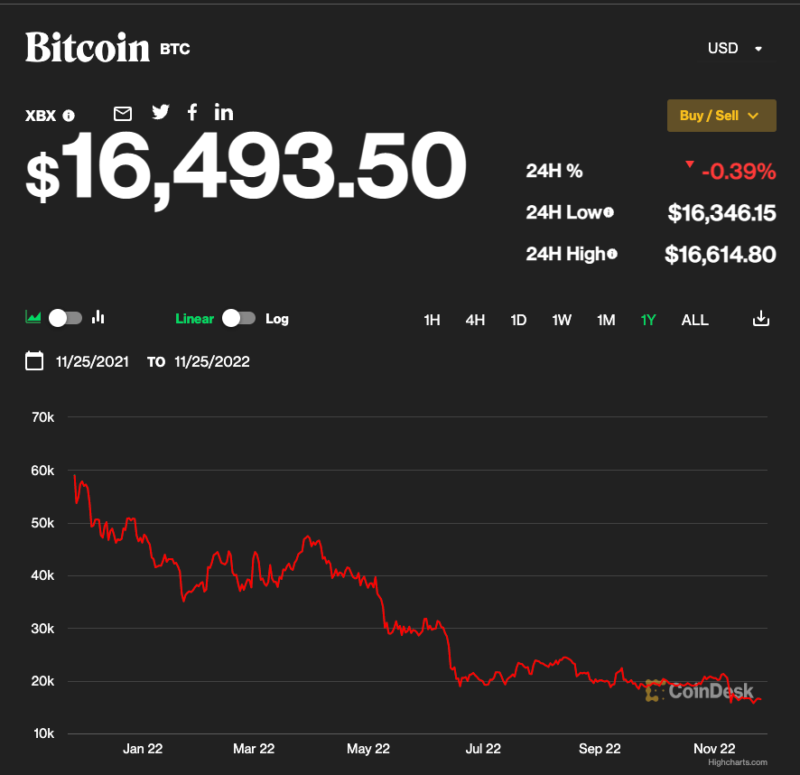Is Crypto Dead? Explaining the Crypto Exchange Crash
The dramatic collapse of FTX is only the latest bad news in a rough 2022 for the cryptocurrency world. Our article has all the details on the crypto exchange crash, from its origins to the future of decentralized finance.
Unfortunately, 2022 was a difficult year for cryptocurrency. The decentralized assets once hailed as the future of money have lurched from crisis to crisis. From a historic summer price crash in May to the implosion of the non-fungible token (NFT) market in August to the November collapse of leading crypto firm FTX, the crypto exchange crash has reached every corner of the economy.
Key Takeaways:
- The FTX crash was caused by a massive loss of investor confidence after a leak revealed that the exchange’s CEO was gambling with customers’ money.
- FTX is only the latest bad news for crypto. Interest rate hikes have been depressing prices for most of 2022, and high-profile bad behavior hasn’t helped.
- If you want to keep your money in crypto, you can protect yourself by getting your money out of exchanges, diversifying your crypto assets and sticking to a regular buying schedule that avoids trying to time the market.
It’s one thing to read the news stories about the crypto industry’s woes, but another to understand them. The market is so obscure and volatile that questions like “what caused all this” and “what does it mean for me” are deceptively difficult to answer. We’ve put together a short guide to help you understand and navigate the cryptocurrency crash.
The FTX Crypto Exchange Crash Explained
The fall of FTX is only the latest twist in 2022’s cryptocurrency panic, but it’s done a lot to worsen conditions overall, including plunging bitcoin’s price well below the “death spiral” level of $21,000. It’s a good place to start our investigation.

FTX is a cryptocurrency exchange that lets ordinary people invest in crypto without having to set up wallets manually (similar to what Vanguard or Charles Schwab do for traditional assets). Helmed by Sam Bankman-Fried, who used to be one of the world’s youngest billionaires, FTX is credited with having increased the price of bitcoin by over 500% in 2021 alone.
As a general cryptocurrency sell-off began in May 2022, FTX stood above the chaos, even making bailout offers to other firms. Its former status as a bulwark against crypto’s decline makes its rapid fall from grace all the more unexpected.
What Caused FTX to Collapse?
In addition to FTX, Bankman-Fried also operates a firm called Alameda Research, which specializes in risky crypto investments. Although the two were meant to be separate, a balance sheet released in early November revealed that many of Alameda’s purchases were made using FTT, a cryptocurrency created and operated by FTX.
Given that many of FTX’s investors had their assets in FTT, the balance sheet revealed that Bankman-Fried was gambling with his customers’ money. The leak led Binance, FTX’s biggest rival, to sell off most of its FTT assets, prompting other FTT owners to do the same — a classic 1930s-style bank run retextured for the modern era.
Since Nov. 8, FTX’s customers have been unable to access their money, affecting more than a million people. On Nov. 11, FTX started its bankruptcy filing.
While we can point to Bankman-Fried’s malfeasance or the Binance sell-off as the proximal causes of FTX’s collapse, the root cause is the nature of cryptocurrencies themselves. Without any inherent value, their prices fluctuate according to public opinion. This means any adverse event can have ripple effects beyond just one currency or firm.
Crypto Dominoes
Since the FTX collapse, there has been a domino effect on other exchanges and cryptocurrencies.
This includes crypto lender BlockFi filing for bankruptcy on Nov. 28, 2022, crypto broker Genesis trying to avoid bankruptcy and the Kraken crypto exchange cutting about 30% of its staff (learn more in our Kraken review). We will likely see many more examples of a market in crisis well into 2023.
What Does the Crash Mean for Crypto?
Long-term, the crash probably doesn’t mean much for crypto, but it’s certainly shaken trust in the technology.
As we said in the introduction, 2022 was a historically bad year for cryptocurrency even before the FTX meltdown. The recent price crash isn’t the first for crypto — a massive crash in 2018 followed the 2017 boom that made “bitcoin” a household term.
However, the latest crash has reverberated more broadly, precisely because cryptocurrency is far more mainstream than it was five years ago. Banks, hedge funds and respected institutions now own assets based on a meme. Going mainstream put crypto in a delicate position: bought enough for its prices to bloat, but not enough to stop being considered a high-risk investment.

All this intensified during COVID-19, when rampant crypto purchases drove bitcoin and other currencies to never-before-seen levels. In essence, 2020 was the 2008 housing bubble moment for crypto. Something had to give.
Why Did Crypto Crash in 2022?
Crypto’s combination of popularity and risk finally became a liability in 2022, when the United States Federal Reserve began taking steps to control inflation. To heavily simplify: the Fed raises interest rates to make saving more attractive than spending, which lowers demand and (theoretically) lowers prices.
When rates are higher, investors move their money from risky bets like crypto to safer bets like U.S. treasury bonds. There’s no reason to tie up your savings in an asset that could crash, when you could make the same returns from an asset that won’t.
Some crypto investors moved their money to “stablecoins,” a supposedly safer form of cryptocurrency with its value pegged to a stable asset. However, even stablecoins come with risk. One popular stablecoin, TerraUSD, was supposed to always be worth exactly the same as the U.S. dollar, but its complicated algorithmic background still caused it to crash.
What’s noteworthy about the 2022 crypto crash is that crypto’s decline is outpacing price drops in more traditionally risky assets. It’s too early to say for sure, but it appears the lack of regulation that once made crypto attractive is now working against it. Antics like Three Arrows Capital abandoning its offices damage confidence in the whole industry.
Will the FTX Collapse Hurt Crypto Prices?
It’s too soon to say what knock-on effects the FTX collapse will have on crypto as a whole. Experts are divided on whether it will have a limited impact or serve as crypto’s “Lehman Brothers” moment.
Research from Coinbase argues that FTX’s badly timed demise will dampen recoveries from crypto’s poor summer, keeping prices cratering for another several months. On the other hand, brokerage firm Bernstein suggests that the collapse could actually benefit crypto if it forces the industry to accept regulations that bolster consumer confidence.
At the moment, the price of bitcoin — often used as a proxy for the health of crypto as a whole — suggests the pessimists are right. In November 2022, bitcoin’s value has declined from a high of over $21,000 to less than $17,000, its plunge mirroring the fall of FTX. As the New York Times reported, one analysis named $21,000 as the value threshold for a “death spiral.”

How to Protect Your Crypto Assets From a Crash
With all the bad news lately, do people who still have money in crypto stand any chance of keeping it? We won’t lie: The picture is dire. However, there are a few steps you can take to mitigate the damage.
Never Invest More Than 10%
Playing risky assets is a viable investment strategy, but you shouldn’t gamble with anything you can’t afford to lose. As a rule, risky assets (crypto included) should never make up more than 10% of your portfolio. This will make it a lot easier to ride out bad news in any one sector.
Withdraw Your Money From Exchanges
If the FTX news has you skeptical about what crypto exchanges are doing with your money, you can set up and manage your own crypto wallet. This will protect you in the event of a rapid collapse that prevents you from accessing exchange funds.
Diversify Your Crypto Portfolio
The use of bitcoin as a price index masks the fact that crypto is an increasingly diverse space. As in the larger stock market, a more diverse portfolio could insulate you from market shocks. Buy multiple currencies, and if you’re still OK with exchanges, put your money in more than one.
Beware of Stablecoins
Stablecoins may seem like a safer option, but as the case of TerraUSD shows, a stablecoin can crash even when the asset it tracks does not. If you want to get your money out of riskier cryptocurrencies, it may be safer to remove it from crypto altogether.
Don’t Try to Time the Market
Rapid price fluctuations are exciting, but consistency is the only true path to wealth in the stock market. A trader who buys $100 of bitcoin every month, rain or shine, will make more over 10 years than a trader who gets lucky on one price spike.
Deduct Lost Investments From Your Taxes
If any of your cryptocurrency investments are worth less now than they were when you bought them, you can use the losses to write off taxes you might have to pay on other gains. Be aware that to get the write-offs, you have to actually sell the underwater assets.
Final Thoughts
To some degree, cryptocurrency is no different from the stock market as a whole. You can refer to Crypto for Dummies if you’d like a complete rundown of the basics. Both run on public perception of value, with securities worth what people are willing to pay for them.
With that said, crypto is riskier than most investments. It’s not tied to anything with inherent value, like commodities, but it’s also not backed by the strength of a government, like bonds or fiat currency. Learn more about crypto controversies in our crypto lawsuit guide.
FAQ
As the Fed hikes interest rates to reduce inflation, safer assets become more attractive than high-risk bets like crypto. This has caused many investors to pull out of crypto, leading to a price drop that’s exacerbated by events like the collapse of FTX.
It’s too soon to say, but many investors are still hopeful. Prices have recovered from “crypto winters” before, including the severe crash of 2018.
The volatility of crypto practically guarantees a boom-and-bust cycle, so it’s safe to say that 2022 isn’t the last time crypto will crash.
Not yet, but some cryptocurrencies — including bitcoin — are in what experts call a “death spiral” after dropping below $21,000 value.


